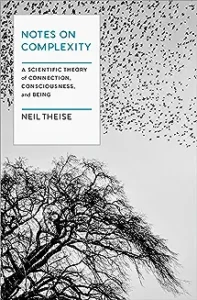Notes on Complexity: A Scientific Theory of Connection, Consciousness, and Being by Neil Thiese 2023
Quite an amazing book which I’m still trying to digest, understand, and consider. Theise, a gay, Jewish child of Holocaust survivors and a pathologist at NYU Langone Medical School, has written a fascinating, provocative, and well-reasoned exploration of the concepts of consciousness, connection, and being based on complexity theory.
In the first part of the book he explains complexity theory, a method of understanding and explaining our world through patterns of organization and interactions. The theory is characterized by being open-ended, evolving, unpredictable, adaptive, and self-sustaining. Complexity theory applies as systems become more, well, er complex. Theories of explanation move from the linear, traditional mathematic situation where the sum of the parts equals the whole to chaos theory where the whole is greater than the parts and which is characterized by self-similar fractals. In situations where disorganization is even beyond fractals, i.e. the interface between chaos and stability, complexity leads to either adaptive evolution or mass extinction. The critical variables that determine whether complexity applies are the numbers of interactors, the local interactions, the negative feedback loops, and the degree of randomness ((too few and you have machines with little flexibility; too many, and you can’t apply self-organization and it won’t work). When the conditions are just right, you have ‘quenched disorder’ and the possibility of ’emergence.’
If that last paragraph is unclear, it’s because I struggled to understand these concepts as Theise moved down the scale from organism to cell to molecule to atom, to the 30 or so subatomic particles, and finally to the quantum foam where the Copenhagen interpretation provided scientific ‘proof’ that space-time and gravity were the fundamental elements of the universe. That provable, scientific theory, however, left us with the ‘hard problem of consciousness’ and from there, Theise largely lost me as he entered the world of metaphysics and spirit.
Theise cites three alternative theoretical frameworks for understanding consciousness– materialist, panpsychism, and idealism and embraces the latter adopting the Platonic Forms as the basis for the Consciousness in the universe. He then goes on to aver that Godel’s incompleteness proof had shown that any explanation of consciousness must go beyond science and mathematics. Hence, his adoption of Idealism and the notion that these Forms are the starting point for all else. Given the failure of science and math to explain consciousness, Theise argues that intuition must have equal standing with empirical science if we are to understand where we are in this universe. He hypothesizes that, in fact, Consciousness is the very substrate of the universe and has created man so that man might understand his creator. Buddhism’s impermanence, interdependence, and emptiness combine with the Kabbalah’s search for the Creator and Hinduism’s non-duality provide Theise with the foundation he uses to wed intuition with science. This combination provides him with an understanding of his place in the universe that results in his ability to cultivate resilience and equanimity in the face of complexity and chaos. I think!
He concludes the book as follows: “Complexity comforts us, revealing, unequivocally, unavoidably, that however separate and alone we might feel, each one of us is—in each and every moment—a pure expression of the entire living, conscious universe. Nothing separate, nothing left out, but true, pure, and complete, just as we are.”
This is not an easy read, but for those of you who are inclined to be awe-struck by our universe, from its quarks to its galaxies, from a butterfly to an elephant, this makes for a provocative view of the whole ball of wax. I should probably read it again, but doubt if I have the will to do so.



